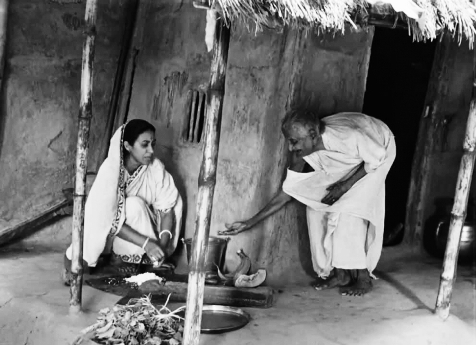 Satyajit Ray’s debut film, from 1955, tells of a young boy and his family in a rural village in Bengal, and was the first Indian movie to gain worldwide attention.
Satyajit Ray’s debut film, from 1955, tells of a young boy and his family in a rural village in Bengal, and was the first Indian movie to gain worldwide attention.
In the history of Indian film, there’s a dividing line between approximately the first forty years of the movie industry, and the release, in 1955, of the first film by Bengali writer and director Satyajit Ray. It’s called Pather Panchali, which roughly translated into English means Song of the Road. Before Pather Panchali, Indian films adhered to a formula of simplistic melodramas or comedies with songs and dancing—in fact, this is the tradition that still dominates today, albeit in a more sophisticated way, and that has come to be nicknamed Bollywood.
Ray worked for ten years as a layout editor at a Calcutta ad agency, but his secret love was cinema. He read all the books and magazines he could find about filmmaking. In 1949, the great French director Jean Renoir arrived in India to make his movie The River, and Ray worked part time for him scouting locations. Renoir encouraged him to pursue his dreams. The following year, Ray put his savings together, got a small loan, borrowed money from his family, and began shooting. Most of his crew had no experience. His cinematographer had never shot a film before.
Pather Panchali was adapted from a well-known autobiographical novel, written in 1928 by the Bengali author Bibhutibhushan Bandyopadhyay. It’s about a poor family in rural Bengal around 1910. The family consists of the parents—the father is often away trying desperately to make a living, the mother frets and scolds and feels lonely—a daughter and son, and an elderly aunt. The story is centered on the 6-year-old son, Apu, and his innocent reactions to what goes on around him in his family and village.
Watching this film is like peeking into an actual place and time. Little details, like the dragonflies playing on the water, create a sense of place while evoking feelings about events that are happening in the lives of the family. The small incidents that go to make up Apu’s life are soul-stirring because of the picture’s basic honesty about people. These characters are not idealized. The mother nags, her desire for security getting the better of her compassion. The father is a dreamer whose irresponsibility puts the family at risk. The sister, Durga, a few years older than Apu, steals things. Yet they are also decent, loving people. The mother in particular (in an amazing performance by Karuna Bannerjee, an amateur, as was most of the cast) gains immeasurably in stature as the film progresses. And the figure of the old auntie is very moving—childish and sometimes petulant, she also shows a gentleness and tolerance much needed by the daughter.
When Ray couldn’t afford any more film, he used bits of the discarded film ends that were left around at the Calcutta studios. But finally, after a year and a half, he ran out of money and filming stopped. After scrambling for over a year, he managed to receive more funding. Working on a deadline, his friend Ravi Shankar composed the film’s musical score in one day. Then it was released—to immediate acclaim and sold-out theaters. It was shown at Cannes and eventually given international distribution. Pather Panchali was the first Indian film to receive worldwide attention.
As it turned out, this was the first in a trilogy. The other two films: Aparajito and Apur Sansar are excellent as well. They follow Apu into adolescence and adulthood, turning the Apu trilogy into a national cinematic epic with Apu representing the soul of India.

Jim Jarmusch has crafted a zombie film—a comedy that somehow manages to maintain an almost somber tone—doubling as a portrait of America under Trump....

Javier Bardem shines in this dark satire about a glad-handing business owner threatened with scandal and controversy. We’ve all seen commercials, and we know...

The story of a paid assassin’s quest to get even with a client who tried to have him killed is a bracing satire on...